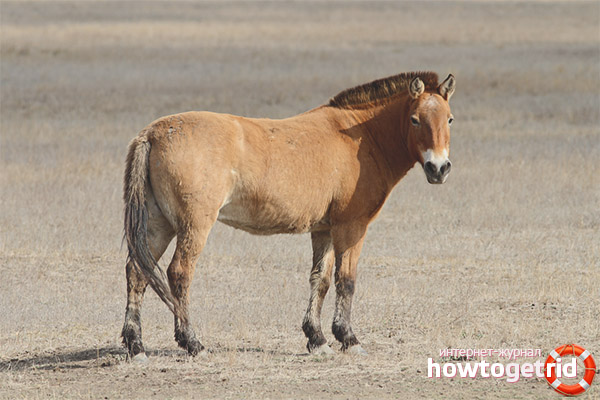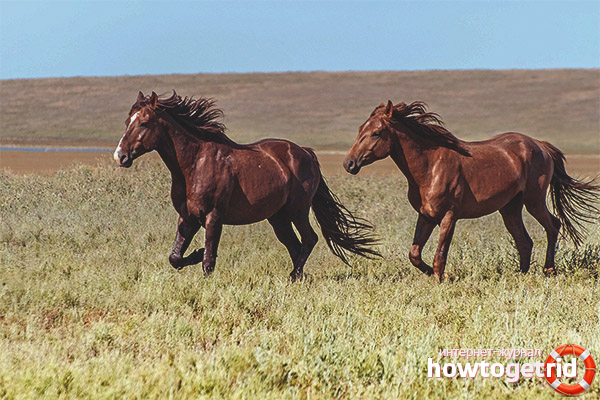The content of the article
Horses are one of the first animals domesticated by humans. With the development of society, wild horses became less and less. Now such animals are found singly. These herds appeared from domestic animals, but for centuries had no contact with humans.
Wild horses are very different from their distant representatives. They have a long mane and tail, but they look fallen and tangled. Wild horses have the opposite. Nature adapted them to the conditions in which they lived. Such individuals looked great even without human departure.
Varieties
There are several subspecies of wild horses:
- Domestic breed.
- Przewalski's horses.
- Tarpani.
At the moment, only a few herds of Przewalski's horses have survived in natural conditions. The tarpans, unfortunately, became extinct, despite attempts to preserve them.
Tarpans
These horses became extinct only through the fault of man. An unreasonable attitude towards them led to the mass death of these animals. Such horses loved freedom very much, were stronger and more enduring than modern home relatives.
Appearance
You can understand how these horses looked from preserved photographs and small descriptions. These individuals were not very tall, their height reached only 140 cm. The body was a little longer than the height and could reach 150 cm.
On the legs, the coat had a darker color. Sometimes there were zebroid marks on the sides. The color of these horses made them invisible in the winter season on snowy expanses and in the summer on dry steppes.
In addition to the steppe tarps, in nature there were their forest counterparts, slightly different in physique and coat color in winter.
Tarpans, like any other horse, were social animals. They could not live alone, so they formed large herds, which could include up to hundreds of individuals. Often the herds were divided into small groups, each of which was certainly led by an alpha male. He directed the herd, put things in order in him, guarded him, and left last in the event of a collision with the enemy.
Tarpanes have always been on the move in search of the most suitable pasture for food. They were very hardy animals and could remain without food and water for quite some time. Some sources claim that the tarpans never slept lying down, and to quench their thirst they had enough morning dew, which settled on the grass.
Repeated attempts to tame these horses always ended in failure. Their violent and evil temper was never conquered.
Where did the tarpans live?
Historically, tarpan lived mainly in the forest-steppe, steppe and desert zones of Eurasia. This can be guessed from the remaining drawings of horses by cavemen. In some documents you can find that the tarpans lived in Spain, Belgium, Switzerland, Poland.
After people began to actively explore the steppes, these horses began to disappear. So, at first they were attributed to forest, and later forest tarpans began to die out. In the center of Europe, these horses ceased to exist in the early Middle Ages. In other areas, this happened centuries later.Such a fast extinction of this species is associated with virgin land development for agricultural use, with deforestation suitable for the construction of houses. Often, tarpans were specially persecuted and killed, since this type of horse harmed actively developing agriculture, and horse meat was considered a delicacy.
Przewalski's horse

Przewalski’s horse is one of the most unique horse breeds. This species disappeared from the wild only a few decades ago. But there are isolated individuals, and they can be found to this day. This species is under special protection worldwide.
These animals appeared from the Tarpan. The view was discovered by Nikolai Przhevalsky, a nature lover and explorer. For the first time he saw this horse in Tibet, and noticed its characteristic features, which sharply distinguished them from other individuals.
As a result of an in-depth study of this breed, a decision was made to immediately add it to the Red Book, since this species was already very small.
Appearance
This type of horse is beautiful, elegant and stately. The coat is warm, thick and hard. Short erect mane, tail long, straight, black. The color is brown, the belly is lighter, giving off yellowness. The limbs are characterized by a dark color.
The head of horses of this species is massive, heavy and strong. The neck is thick, the mane is black. The nostrils are large, catching various odors well. The legs are short but strong and hardy.
Where did Przewalski’s horses live?
It is believed that this type of horse came out of a place called Tahiin-Shara-Nuru. These individuals were found there everywhere. The first studies of Przhevalsky horses were in the Dzungaria or Central Asia.
Herds of these horses did not climb high above sea level. They grazed mainly in the steppes on the slopes, which did not reach great steepness. These horses are a restless species. They never stayed long in one place, preferring to search for increasingly rich steppes for food. The wide distribution of this breed in Dzungaria is due to the fact that in these territories there was a lot of fresh water and a large number of fertile steppes.
Many countries place Przewalski’s horses in national parks where animal breeding is underway. Most animals are equipped with tracking sensors to track the movement of individuals throughout the park, as well as to prevent the occurrence of dangerous situations.
Now Przhevalsky horses can be found in the Askania-Nova reserve, located in Ukraine, in the national parks of America, Europe, Hungary, as well as in the Orenburg reserve.
Video: wild horse (Equus ferus)










Submit